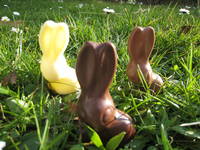Life cycle assessment and carbon footprint of dark, white, and milk chocolate

Easter is coming soon, and an increasing selection of Easter sweets can be found in many households. But which chocolate is the most environmentally friendly? The CO2 footprint and the European footprint were calculated for an LCA case study of 100 g Easter bunnies made of dark, white, or milk chocolate. The Easter bunnies made from dark chocolate perform best in this case.
Different types of chocolate
Basically, the different types of chocolate differ in their composition. While the proportion of cocoa butter in dark chocolate is very low, the proportion of other cocoa parts (e.g., cocoa powder) is very high. This proportion shifts in the opposite direction as the chocolate gets lighter. For example, white chocolate – hence the colour – no longer contains cocoa powder. In addition, milk powder is added to white and milk chocolate.
LCA of the environmental impacts of Easter bunnies
The evaluation of the contribution to climate change of these variants shows that the larger the proportion of milk powder, the higher the carbon footprint (see Fig. 1). The carbon footprint is comparable to a car journey of 900 m for 100g of dark chocolate and 1.7 km for white chocolate. The same trend can also be seen in the European footprint method (Fig. 2), which combines 16 different environmental indicators, such as the CO2 footprint, but also water consumption and air pollutants. While the contribution to climate change is also very relevant there, it turns out that land use (fodder for milk cows and cocoa production) and fossil energy consumption (energy use for production) are also relevant environmental indicators that must be taken into account. Packaging has a smaller impact on the overall balance but becomes more relevant the smaller the footprint of its contents becomes.
Basically, it is advisable to avoid animal products as much as possible. This also applies to processed foods, such as chocolate. The ESU recommendation for Easter is therefore: It is better to buy dark chocolate bunnies than white ones.
Modelling assumptions: For this evaluation, the evaluation was carried out using the IPCC 2021 GWP100a method and the European Footprint 3.1 method. The entire life cycle of an Easter bunny was considered. This means from the cultivation of the ingredients (e.g., cocoa) to related transports, as well as the production of the chocolate, sale, and (private) transport to the consumer, as well as the disposal of the packaging. The 12 g of packaging is considered per 100g of Easter bunny. The dataset is valid for Europe and originates from the ESU-World Food Database.
Figures for the environmental impacts and carbon footprint of Easter bunnies


Publications related to environmental impacts of chocolate
Niels Jungbluth, Alex König (2014) Life Cycle Assessment of Swiss Chocolate. SETAC Europe 24th Annual Meeting, Bale, 15th May 2014, Paper “Environmental impacts of chocolate in a life cycle perspective“
Büsser S. and Jungbluth N. (2009) LCA of Chocolate Packed in Aluminium Foil Based Packaging. ESU-services Ltd. Uster, Switzerland. Commissioned by German Aluminium Association (GDA) in cooperation with European Aluminium Foil Association (EAFA), Düsseldorf, Germany.